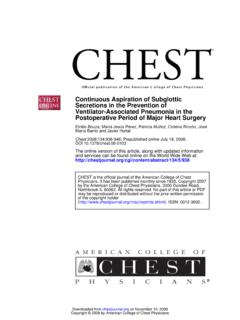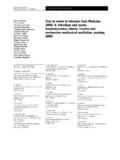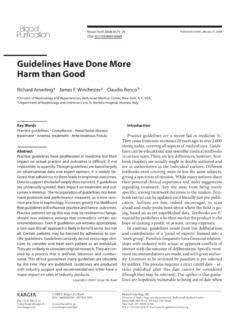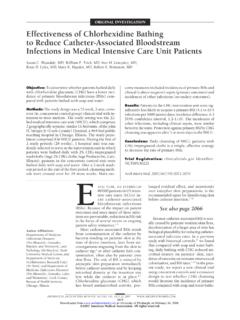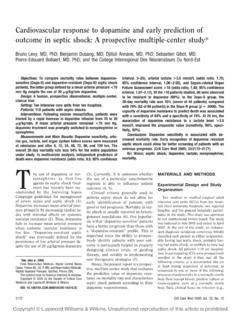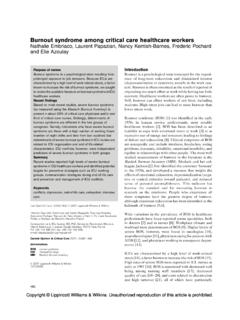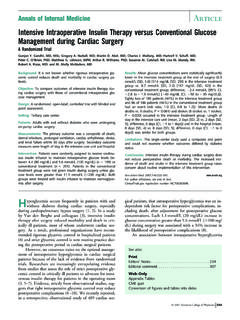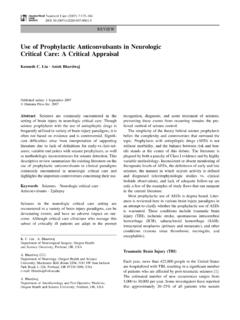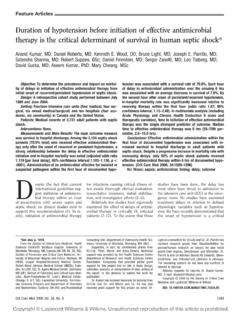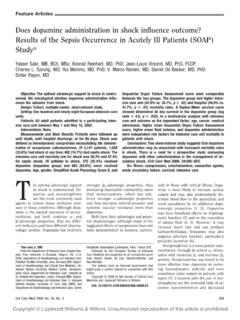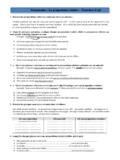Transcription of A New Era for Sedation in ICU Patients - ccmpitt.com
1 Current as of February 5, 2009. Online article and related content . 2009;301(5):542-544 ( ) JAMA Hannah Wunsch; John P. kress A New Era for Sedation in ICU Patients Correction Contact me if this article is corrected. Citations Contact me when this article is cited. Topic collections Contact me when new articles are published in these topic Care; Psychiatry; Delirium; Prognosis/ Outcomes; Drug Therapy; Drug Therapy, Neurology; Neurology, Other; Critical Care/ Intensive Care Medicine; Adult Critical the same issueRelated Articles published in . 2009;301(5) R. Riker et al. Randomized TrialDexmedetomidine vs Midazolam for Sedation of Critically Ill Patients : A Alerts at University of Pittsburgh on February 5, 2009 from EDITORIALE ditorials represent the opinionsof the authors andJAMA andnot those of the American Medical New Era for Sedation in ICU PatientsHannah Wunsch, MD, MScJohn P.
2 kress , MDCRITICALLY ILL Patients FREQUENTLY REQUIRE IN-vasive monitoring and other support that can leadto anxiety, agitation, and of Sedation isessential for the comfort and safety of these pa-tients. Options for Sedation in the intensive care unit (ICU)are limited, with benzodiazepines and propofol the most com-mon ,3In the past, these agents were generally usedto keep Patients motionless and to reduce memory of theirexperience in the ICU. However, recognition that heavy se-dation may increase mortality and morbidity has led to anew model in which the emphasis is on maximizing the com-fort of these Patients while they remain interactive, ori-ented, and able to follow new model re-lies on strategies such as daily interruptions of Sedation ,5use of scores such as the Richmond Agitation- Sedation Scaleto maintain target Sedation level,6and minimizing the useof paralytic important consequence of lighter Sedation is thatphysicians and critical care staff can now routinely assessthe cognitive function of critically ill Patients .
3 Recent stud-ies suggest that delirium is a common complication ofbeing in the ICU that is often diagnosed only throughactive assessment by clinicians and that may be present inpatients who, when observed from the foot of the bed,look calm and , delirium isindependently associated with cognitive impairment athospital discharge and with 6-month , the Sedation agents, particularly benzodiazepines,are potential causes of delirium,10prompting the questionof whether other sedative agents may represent a relatively new drug, dexmedetomidine, has shownpromise as a sedative agent for ICU Patients and maydecrease the occurrence of a combined end point ofdelirium or is an 2receptoragonist and close relative of clonidine that works viareceptors distinct from the -aminobutyric acid receptorfor benzodiazepines and propofol. As a sedative, dexme-detomidine is notable for its lack of suppression of the res-piratory drive and for its potential to provide some analge-sia and ,13 For these reasons, this agent ispotentially useful for Sedation of critically ill , for the past 8 years, dexmedetomidine has beenapproved by the US Food and Drug Administration onlyfor use up to 24 hours in mechanically ventilated Patients ,at a dose no higher than g/kg per hour, limiting itsuse for Sedation of ICU this issue ofJAMA, Riker and colleagues14provide datato support the idea that the development of delirium maybe modifiable by choice of sedative by comparing dexme-detomidine and midazolam infusions in mechanically ven-tilated Patients .
4 The authors received permission to use dosesof dexmedetomidine up to twice the limit approved by theFood and Drug Administration, and for up to 30 days of me-chanical ventilation, with the dual goal of assessing the safetyand efficacy of the extended dosing regimen. This large,double-blind, randomized controlled trial showed a de-crease in the rate of delirium in critically ill Patients se-dated with dexmedetomidine compared with midazolamand a concomitant decrease in the time to extubation. Butperhaps most important, this study, in conjunction with arecently published trial by Pandharipande et al,11helps toestablish dexmedetomidine as a safe alternative to benzo-diazepines for long-term Sedation of critically ill evaluations of the safety of dexmedetomidine, thesestudies are complimentary. The trial by Pandharipande etal11involved Patients from only 2 centers but was able toprovide follow-up information on Patients after dischargefrom the hospital.
5 Pandharipande et al found a decrease ina combined end point of days alive without delirium or comausing dexmedetomidine vs lorazepam. The trial by Riker etal14included Patients from a much larger mix of ICUs inmultiple countries. The trade-off in this study was more lim-ited follow-up, likely owing to the logistical challenge of datacollection in a multicenter setting. Taken together, these stud-ies shift dexmedetomidine from a sedative suitable for theoccasional patient to one useful for a majority of criticallyill also p Affiliations:Department of Anesthesiology, Columbia University, New York,New York (Dr Wunsch); Department of Medicine, University of Chicago, Chi-cago, Illinois (Dr kress ).Corresponding Author:John P. kress , MD, Department of Medicine, Universityof Chicago, 5841 S Maryland Ave, MC 6026, Chicago, IL 60637 4, 2009 Vol 301, No. 5(Reprinted) 2009 American Medical Association.
6 All rights reserved. at University of Pittsburgh on February 5, 2009 from A notable aspect of the design of the study by Riker etal14was the emphasis on keeping Patients lightly sedatedthroughout the study period, focusing attention on the ideathat heavy Sedation is not often needed, even for patientsrequiring mechanical ventilation for longer than 3 days. Thetarget Richmond Agitation- Sedation Scale score ranged from 2 (light Sedation ) to 1 (restless) at all times. In fact, thetime Patients spent within this target range represented theprimary outcome for the study. The authors were unableto prove their primary hypothesis, which was that patientssedated with dexmedetomidine would be in the target se-dation range longer than those sedated with midazolam. Butboth groups were maintained in the appropriate light seda-tion range for an encouraging 75% of the study by Riker et al14also illustrates a number of de-sign challenges for trials of Sedation practice.
7 When deter-mining the care to be used for the control population, theinvestigators had to find a sedative used commonly, givento Patients in the same way as the study drug (such as viainfusion) to allow for blinding, and dosed in a manner thatallows for equivalence between the study groups yet thatstill allows for flexibility in dosing according to the needsof individual Patients . Other decisions involve whether tomandate certain protocols, such as daily interruption of se-dation or use of weaning methods, which may be consid-ered best practice but do not always represent common prac-tice,15as well as whether to allow bolus administration ofthe same or other medications to maintain adequate seda-tion, which may cloud the interpretation of results. Rikeret al14chose to initiate midazolam infusions at mg/kgper hour (approximately 5 mg/h for their average pa-tient a relatively high dose), did allow open-label bolusesof midazolam in both groups (which risked diluting the hy-pothesized benefit in the dexmedetomidine group) as wellas fentanyl boluses, and included targeted Sedation , withassessment at least every 4 hours.
8 There were no man-dated daily interruptions of Sedation and no use of speci-fied mechanical ventilation weaning protocols, both of whichmight have decreased the amount of midazolam , many questions remain unanswered. Becausebenzodiazepines have shown the greatest association withdelirium,10and guidelines recommend midazolam only forshort-term use due to unpredictable awakening and timeto extubation with longer use,2it is perhaps not surpris-ing that infusion of midazolam for multiple days resultedin longer time to extubation. It remains unclear whetherdexmedetomidine would produce the same decrease indelirium and improvement in time to extubation if it werecompared with another medication such as propofol oreven inhaled anesthetic benzodiazepinesgiven as bolus rather than infusion may have reduceddelirium and length of mechanical ventilation in the mid-azolam group also remains an important question,17although one difficult to assess in blinded fashion.
9 A largerissue is whether delirium induced by medications such asmidazolam is equivalent to delirium due solely to underly-ing critical , the choice of sedative agent for a critically illpatient is just one of hundreds of decisions that occur dur-ing the course of care. The study by Riker et al14is impor-tant in helping to recognize the potential implications ofsuch decisions. With advances in technology, critical careclinicians have become increasingly skillful at stabilizingpatients and supporting organ systems but now are mov-ing beyond a focus on this short-term goal. Rather, it isimportant to recognize that apparently minor decisionssuch as the choice of Sedation may have broad implica-tions for evidence has linked use of Sedation protocols withimprovements in duration of mechanical ventilation, ICUand hospital lengths of stay, iatrogenic complications of criti-cal illness, and tracheostomy ,18,19 For Patients , criti-cal illness does not begin or end within the confines of theICU but also can have profound implications for long-termsurvival,20quality of life,21posttraumatic stress disorder, de-pression, and decreases in physical inter-mediate outcomes, such as delirium.
10 Have been previouslyoverlooked as potentially modifiable factors that may ulti-mately contribute to the long-term morbidities associatedwith critical study by Riker et al14failed to demonstrate thatdexmedetomidine was superior to benzodiazepines forensuring light Sedation . However, the reduced prevalenceof delirium is an important secondary outcome that bothhighlights the problems of traditional benzodiazepinesand provides encouraging data regarding the potentialbenefits of dexmedetomidine. With the demonstration ofthe safety of dexmedetomidine at higher doses and forlonger periods, clinicians now have a widened choice ofsedatives and should always consider not only the need forsedation but also the possible clinical implications of thechoice of Online: February 2, 2009 ( )Financial Disclosures:Dr kress reported serving on the speakers bureau for Hospira,which manufactures dexmedetomidine.
